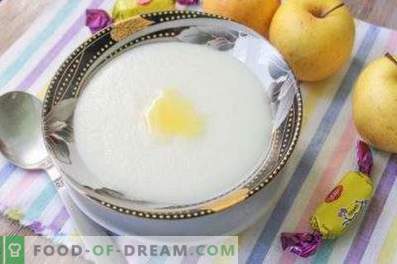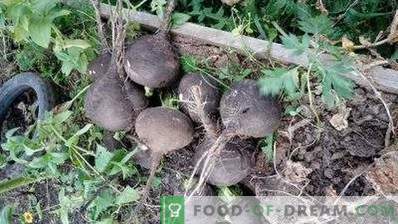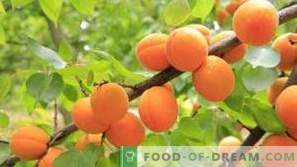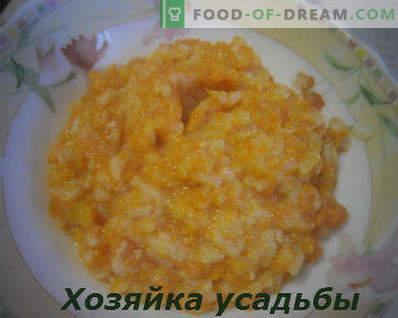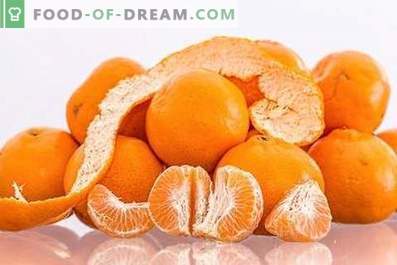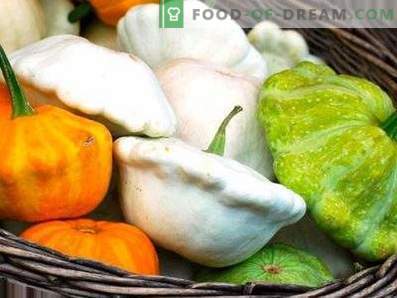
Dish pumpkin, or squash, is a plant belonging to the Pumpkin family. The homeland of the vegetable is the territory located in the central and southern part of America: the scientists found that the locals mastered the technology of its cultivation more than 5,000 years ago. In the 17th century, the Spanish conquistadors brought patissons to Europe. Over the past 400 years, the range of the plant has become much wider: today it is cultivated in most countries with a temperate climate.
Squash is eaten as fried, marinated, stewed, canned and baked. Caviar, stews, and side dishes for meat dishes are made from the pulp of immature fruits. The pulp and seeds of plate pumpkin are used in alternative medicine for the treatment of cardiological, gastroenterological, endocrine diseases and other pathologies.
Botanical description of the squash
Squash is a herbaceous plant with a well-developed, fibrous root. The weave or erect stalks of a plate-shaped gourd are covered with sharp thorns or thin stiff hairs. Large green leaves of a plant sitting on elongated petioles have a pentagonal or triangular shape. Hard fluff is also present on their surface.
Peachas bloom closer to mid-summer with large dioecious flowers of orange or bright yellow. The fruits of the plant are rounded false berries with oblate edges. The warty or smooth surface of disc pumpkins may have a white, yellow or green color. Under the skin of the fruit hides the elastic tender flesh and a lot of flattened oval seeds.
Nutritional value of squash
100 g of raw squash contains:
- 0, 588 g of proteins;
- 5, 498 g of carbohydrates (including 4, 077 g of sugars);
- 0, 093 g of fat;
- 91, 873 g of water;
- 1,299 g of fiber;
- 0, 091 g of organic acids;
- 0, 977 g of pectins;
- 0, 687 g of ash.
There is no cholesterol, starch and dextrins in the pulp of this plant.
Vitamins in the squash
Pumpkin dishes are rich in vitamins. 100 g of this product contains:
- phylloquinone, K - 1, 087 mkg;
- choline, B4 - 8, 109 mg;
- ascorbic acid, C - 19, 061 mg;
- thiamine, B1 - 0, 562 mg;
- pyridoxine, B6 - 0, 107 mg;
- alpha-tocopherol, E - 0, 094 mg;
- riboflavin, B2 - 0, 034 mg;
- nicotinic acid, PP - 0, 639 mg;
- folic acid, B9 - 29, 894 μg;
- pantothenate, B3 - 0, 096 mg.
Beta carotene is also present in the pulp of the squash. The concentration of this compound is 127, 774 μg per 100 g of product.
Useful items in a plate pumpkin
Trace elements in 100 g of squash:
- boron - 19,668 mcg;
- cobalt - 0, 944 mcg;
- nickel - 3, 096 mkg;
- vanadium - 6, 314 mkg;
- zinc - 289, 638 mcg;
- manganese - 189, 704 mcg;
- iron - 0, 344 mg;
- selenium - 0, 198 μg;
- copper - 74, 117 μg;
- rubidium - 5, 573 mkg;
- iodine - 0, 274 mkg.
Macroelements composed of dish pumpkin (100 g):
- phosphorus - 19.044 mg;
- calcium - 16, 072 mg;
- sodium - 3, 077 mg;
- magnesium - 24, 703 mg;
- silicon - 28, 044 mg;
- Potassium - 189, 414 mg.
Calories of squash
100 g of raw squash contains 18, 748 kcal. The energy value of the fruit of medium size (250 g) - 46, 87 kcal. In a glass of pumpkin pulp - 28, 122 kcal, in a tablespoon - 3, 749 kcal, in a teaspoon - 1, 312 kcal. The caloric value of 100 g of fried squash is 81, 709 kcal, stewed - 18, 904 kcal, pickled - 17, 993 kcal, baked - 21, 012 kcal. The energy value of a 100-gram serving of squash caviar - 81, 683 kcal.
Useful Properties
- Squash - tasty and nutritious vegetables with low energy value. Cooked meals from them can be the basis of dietary nutrition for people who decide to lose weight.
- Dish pumpkin contains vitamin E, potassium, ascorbic acid and other substances that can slow down the aging process of the body.
- Squash - rich sources of substances that strengthen the immune system.
- The antioxidant compounds that this vegetable is rich in protect cells from the negative effects of free radicals. With regular consumption of it reduces the risk of developing tumor tumors.
- Vitamins of group B and other nutrients contained in the squash pulp heals the nervous system and prevents the development of somnological disorders. People who consume it daily for food, more easily tolerate nervous shocks and stress, rarely face mood swings, manifestations of neurosis and depression.
- The juice of this vegetable contains a whole set of substances that contribute to the production of hemoglobin, normalizing the work of the hematopoietic system. The drink is useful for people suffering from anemia.
- Potassium and magnesium, present in the pulp and seeds of dish pumpkin, regulate the heartbeat, strengthen the heart muscle, increase the strength and elasticity of the vessel walls, maintain blood pressure within normal limits, prevent the formation of blood clots. Dishes from this vegetable are useful for people predisposed to strokes and heart attacks, suffering from hypertension, ischemia of the heart, varicose veins, thrombosis, atherosclerosis.
- Squash - a rich source of fiber. Vegetable helps to eliminate toxins, excess fluid and harmful cholesterol.
- Dishes from disc pumpkins help speed up metabolism.
- Squash juice has choleretic and diuretic properties. Therefore, folk healers recommend this drink to people suffering from diseases of the urinary system and biliary tract.
- The pulverized pumpkin seeds, crushed into a pulp, have anthelmintic properties. With parasitic invasions, it is necessary to eat at least 3 tbsp. spoons of this tool per day.
- A squash is a mild laxative. A drink made from the juice of this vegetable and honey helps to cope with long-term constipation, flatulence, intestinal colic.
- Disc pumpkin seeds help to normalize the endocrine system. Dried vegetable raw materials are ground in a coffee grinder and eaten 20 minutes before each meal. Single dose of therapeutic and prophylactic agent - 2 tbsp. spoons.
- In folk medicine, squash is treated with wound that does not heal for a long time.
- The juice obtained from this vegetable helps to alleviate the condition of people suffering from intestinal dysbiosis.
- Useful compounds present in the composition of squash helps to normalize the level of oxalic acid in the body, stimulate protein metabolism. Therefore, this product is very often included in the diet menu for persons suffering from gout.
- Dish pumpkin contains lutein and other compounds that positively affect the state of the visual apparatus, reducing the risk of asthenopia (increased visual fatigue) and astigmatism (reduced image clarity caused by a violation of the shape of the eye, its cornea or lens). Dishes from this vegetable are very useful for people who have to spend a lot of time in front of a computer monitor.
- Squash pulp is used to prepare a cosmetic mask that rejuvenates, softens and brightens the skin. Vegetable grate and impose the resulting gruel on problem areas for 20 minutes.
Contraindications and harm of squash
- It is forbidden to eat pumpkins that have grown up on a bed for more than 2 weeks. In the pulp of such fruits accumulate caustic compounds that can cause severe intoxication of the body.
- Dish pumpkin is a potential allergen. People suffering from food allergies should be carefully included in the diet.
- Squabs are contraindicated for persons who have previously been diagnosed with abnormalities in the pancreas, diabetes mellitus, gastric or duodenal ulcer, hypotension.
- Dish pumpkin dishes are not recommended for nursing mothers, women during pregnancy and children under 10 years of age.

